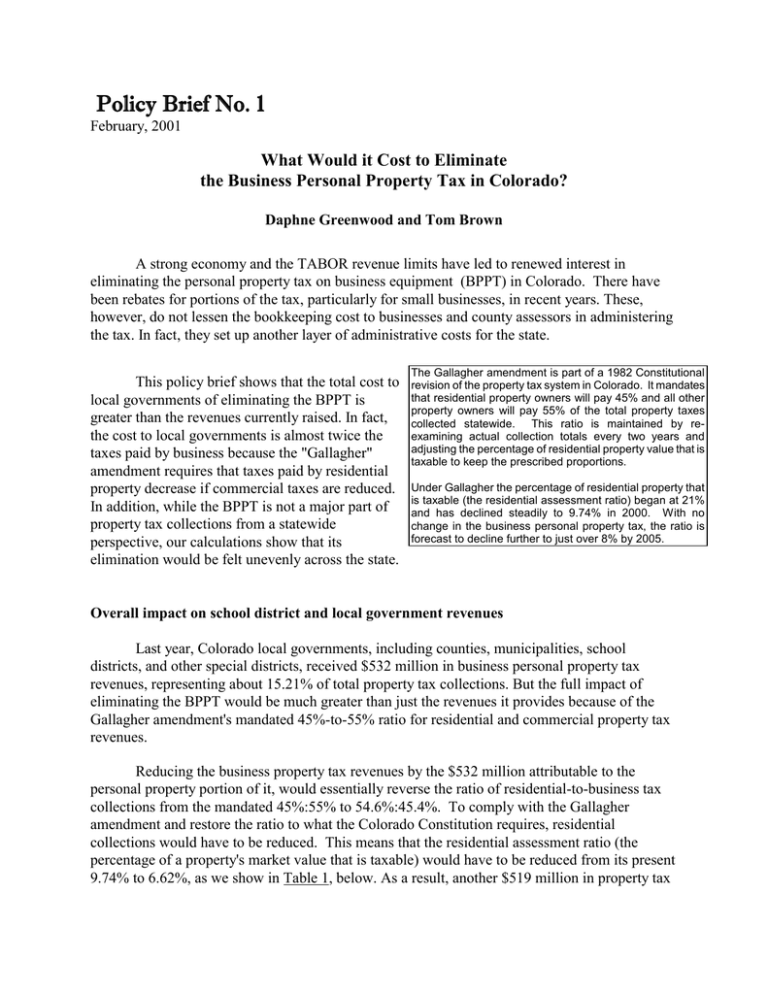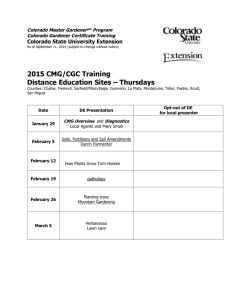Policy Brief No. 1 What Would it Cost to Eliminate
advertisement

Policy Brief No. 1 February, 2001 What Would it Cost to Eliminate the Business Personal Property Tax in Colorado? Daphne Greenwood and Tom Brown A strong economy and the TABOR revenue limits have led to renewed interest in eliminating the personal property tax on business equipment (BPPT) in Colorado. There have been rebates for portions of the tax, particularly for small businesses, in recent years. These, however, do not lessen the bookkeeping cost to businesses and county assessors in administering the tax. In fact, they set up another layer of administrative costs for the state. This policy brief shows that the total cost to local governments of eliminating the BPPT is greater than the revenues currently raised. In fact, the cost to local governments is almost twice the taxes paid by business because the "Gallagher" amendment requires that taxes paid by residential property decrease if commercial taxes are reduced. In addition, while the BPPT is not a major part of property tax collections from a statewide perspective, our calculations show that its elimination would be felt unevenly across the state. The Gallagher amendment is part of a 1982 Constitutional revision of the property tax system in Colorado. It mandates that residential property owners will pay 45% and all other property owners will pay 55% of the total property taxes collected statewide. This ratio is maintained by reexamining actual collection totals every two years and adjusting the percentage of residential property value that is taxable to keep the prescribed proportions. Under Gallagher the percentage of residential property that is taxable (the residential assessment ratio) began at 21% and has declined steadily to 9.74% in 2000. With no change in the business personal property tax, the ratio is forecast to decline further to just over 8% by 2005. Overall impact on school district and local government revenues Last year, Colorado local governments, including counties, municipalities, school districts, and other special districts, received $532 million in business personal property tax revenues, representing about 15.21% of total property tax collections. But the full impact of eliminating the BPPT would be much greater than just the revenues it provides because of the Gallagher amendment's mandated 45%-to-55% ratio for residential and commercial property tax revenues. Reducing the business property tax revenues by the $532 million attributable to the personal property portion of it, would essentially reverse the ratio of residential-to-business tax collections from the mandated 45%:55% to 54.6%:45.4%. To comply with the Gallagher amendment and restore the ratio to what the Colorado Constitution requires, residential collections would have to be reduced. This means that the residential assessment ratio (the percentage of a property's market value that is taxable) would have to be reduced from its present 9.74% to 6.62%, as we show in Table 1, below. As a result, another $519 million in property tax revenues would be eliminated. Because of this "Gallagher" effect, eliminating the BPPT would mean a total property tax revenue loss to local governments of $1.05 billion, based on 2000 assessed values. Differences in impact from county to county From Table 2, the importance of business personal property in total assessed property varies considerably by county. In northwestern Colorado's Moffat County personal property is 45% of total assessed value and in northeastern Colorado's Morgan County it is 41%. Large power plants in these counties account for most of this. The lowest percentage is 3% in southwestern Colorado's Ouray County and in Pitkin County (Aspen). El Paso County is slightly above average at 15.6%, while Pueblo County is 25% and Denver is 18%. Counties with higher than average ratios would feel a greater impact if the BPPT were eliminated. District by district impact The actual amount of BPPT paid by a business depends upon the combination of local governments that have jurisdiction over a particular location. Every place in the state is subject to at least a county and a school district, both of which levy the tax. Most locations are also subject to a variety of municipal and special district governments, some of which levy the tax while others do not. The available data allow calculation only of locally assessed business personal property for each local government, because properties of companies assessed on a statewide basis by the Division of Property Tax are not included. 1 An analysis of over 1300 local governments for which data is available indicates that while locally assessed business personal property accounts for only 8.28%2 of taxable property statewide, there is considerable variation across the state. It accounts for 20% or more of local property tax revenues in 45 districts. Many of these are fire, library, and other special districts with no revenues other than property tax. The highest ratio is 41% for the West Routt Fire District in Routt County while it is less than 1% for many others. A full listing of local taxing districts and their dependence on locally assessed BPPT revenues is shown alphabetically in Appendix A. Allocating state assessed revenues among the districts would require additional data and would change the results somewhat, but is unlikely to alter the wide variability we show here. Conclusion As we illustrate above, Gallagher provisions interact with the BPPT in ways that are not always clearly understood. Eliminating a commercial tax requires an almost commensurate lowering of residential taxes. This is just one of many examples in the Colorado revenue system where various constitutional provisions and tax law interact in complex ways. Without a 1 These are large companies with properties in more than one county. Utilities, railroads, pipelines and telecommunications comprise a large part of the group. 2 Including state assessed properties would raise this to over 15%. comprehensive tax reform, these interactions cannot be addressed. In addition, the dependence of so many local governments providing essential services on locally assessed taxes means that tax policy changes can have widely disparate effects in different parts of the state, and even of any one county. Without some provisions for revenue sharing, elimination of the BPPT would bear much more heavily on some than others. ! Daphne T. Greenwood, (B.A., 1972, Northern Illinois University; M.A., 1974, University of Houston; Ph.D., 1980, University of Oklahoma) is professor of economics at the University of Colorado at Colorado Springs and director of the Center for Colorado Policy Studies. Her research includes public policy and applied econometric work. She has published extensively in journals such as Public Finance Quarterly, the Review of Income and Wealth, the Journal of Economic Issues, and the Journal of Population Economics. Greenwood worked with the U. S. Treasury Department during 1982-83 on its major tax reform design effort. She later served as a representative in the Colorado General Assembly, as a member of the House Finance Committee, and as a member of the 1993 Interim Tax Policy Committee. Tom Brown (B.A. 1963, University of Texas at El Paso; J.D. 1969, University of Louisville; Ph.D. 1999, University of Colorado) serves as research associate with CCPS. He has conducted extensive research in the area of Colorado local government taxation and finance. His dissertation, Constitutional Tax and Expenditure Limitation in Colorado: The Impact on Municipal Governments, reflects extensive research in local government finances. More recently, working closely with local officials across the state, Dr. Brown completed another analysis, Amendment 21: The Impact on Local Governments. His work has recently been published in Public Budgeting & Finance. Dr. Brown was previously an attorney practicing in areas of federal civil appeals, anti-trust litigation, and complex reorganization bankruptcies.


